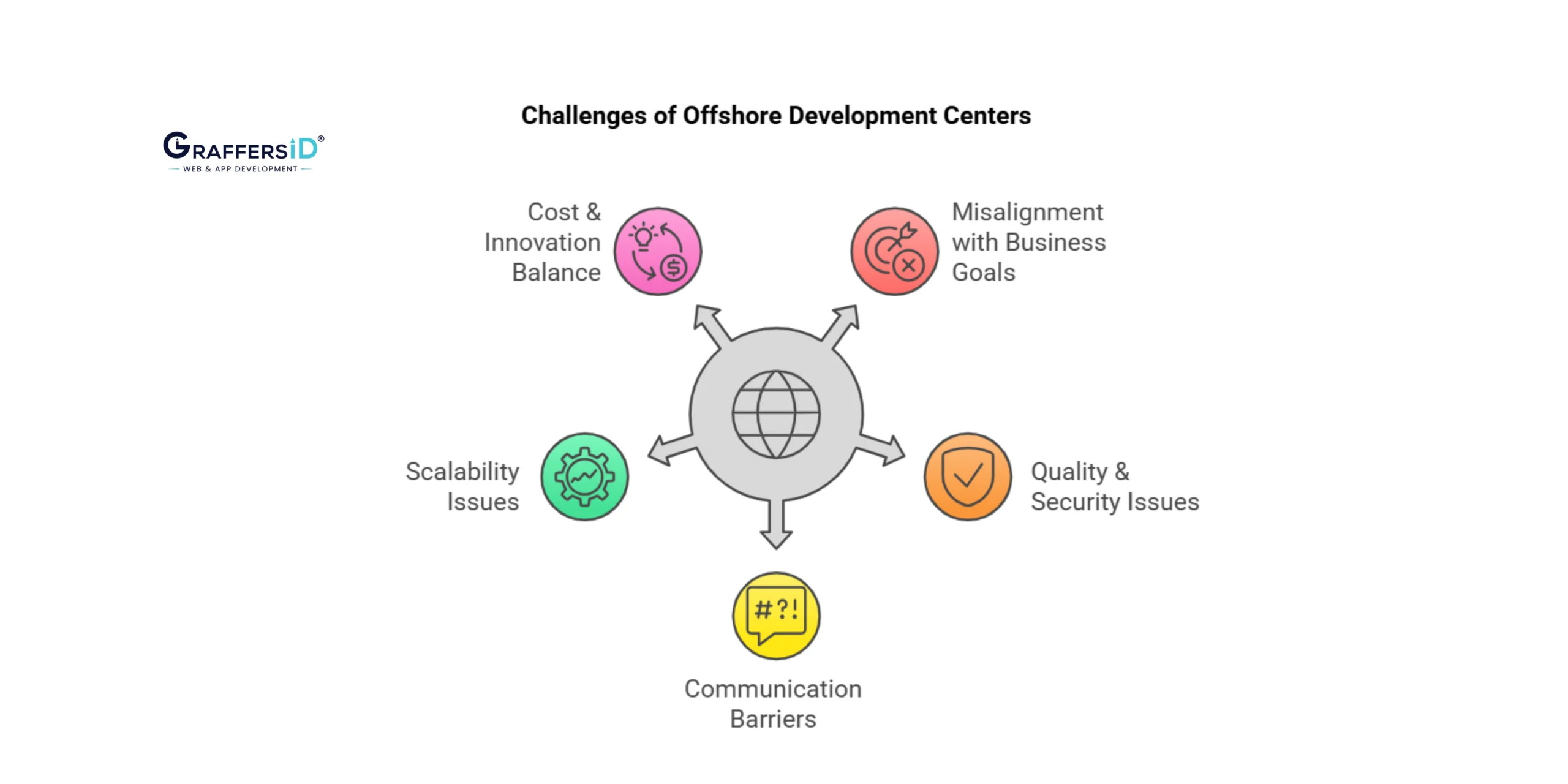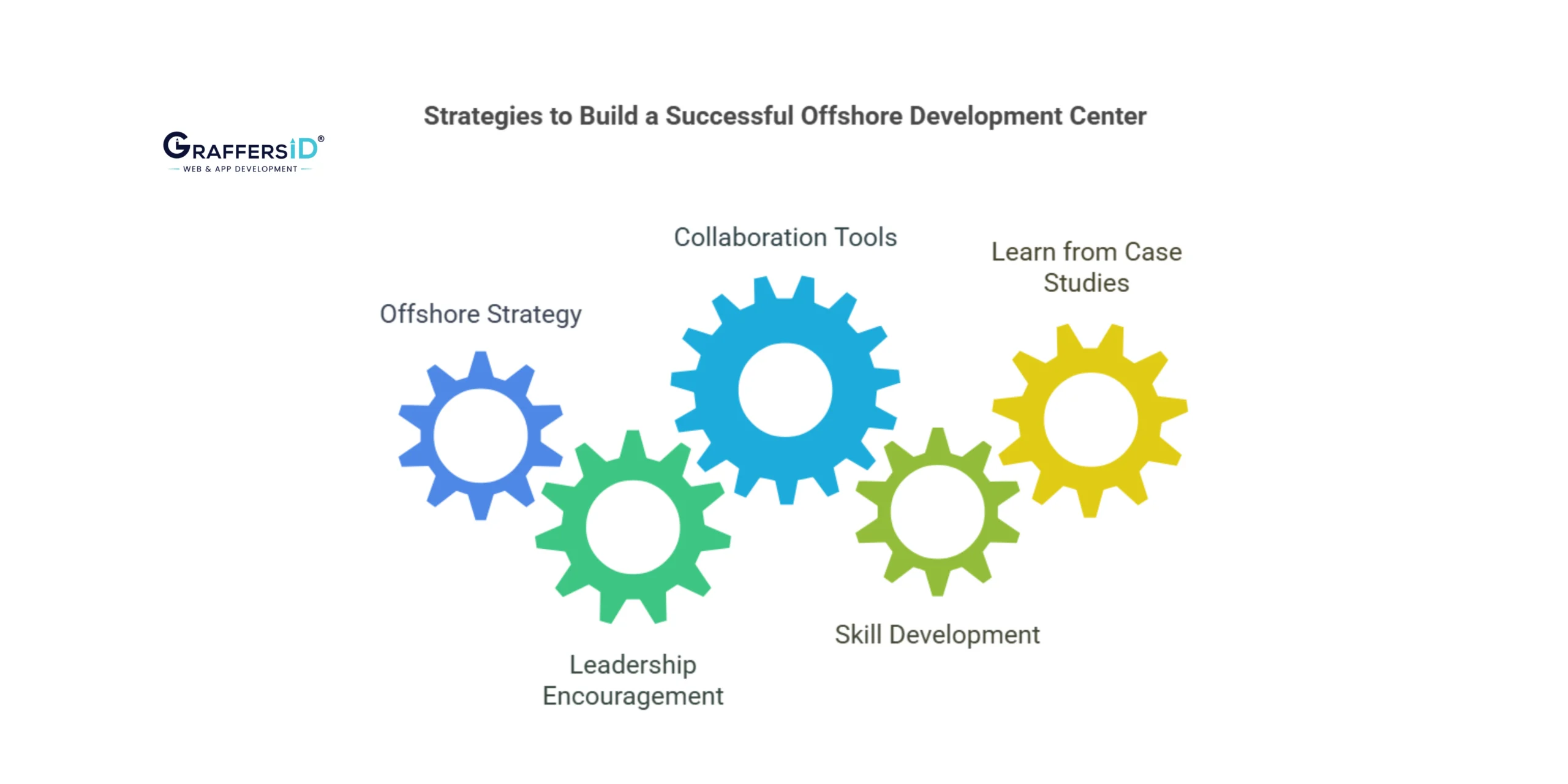Offshore development centers have become an attractive option for businesses looking for cost-effective software development, global talent, and increased scalability. Business leaders who want to gain a competitive edge often use offshore development services. However, even with all of its benefits, offshore development has its own set of challenges that, if not managed well, can affect a company’s success.
To gain the full advantage of offshore development centers, businesses need to address issues like misaligning company objectives, quality issues, communication and cultural barriers, scalability, and balancing innovation with cost.
This article will look at the key challenges of offshore development centers, along with methods to resolve them to ensure smooth collaboration with offshore teams.
Understanding the Major Challenges of an Offshore Development Center
Offshore development centers offer access to global talent and cost-effective solutions. However, its challenges may slow down progress if not properly handled.
Why Businesses Struggle with Offshore Teams?
- Lack of Business Alignment: Offshore teams may not fully grasp the company’s vision and objectives, leading to output that doesn’t align with business needs.
- Quality & Security Issues: It can be challenging to maintain code quality and data security internationally, particularly when working with different legal requirements.
- Communication & Cultural Barriers: Differences in language, work culture, and time zones can cause operational inefficiencies and impact successful collaboration.
- Scalability Problems: Fast-growing businesses must scale, but offshore teams may find it difficult to adjust quickly.
- Cost vs. Innovation: While cost savings are a big advantage, some businesses struggle to drive innovation while reducing expenses.

Read More: How to Set Up the Offshore Development Team in India?
Challenges vs. Solutions
| Challenge | Solution |
| Business Misalignment | Set defined KPIs and OKRs to help offshore teams align with company objectives. |
| Quality & Security Risks | Choose certified partners, conduct audits, and implement strict security policies. |
| Communication Barriers | Use collaboration tools, schedule overlapping work hours, and provide cultural training. |
| Scalability Issues | Choose flexible engagement models and cloud-based infrastructure. |
| Cost vs. Innovation | Invest in upskilling teams, use AI, and focus on value-driven outsourcing. |
Company owners must find innovative ways to overcome these challenges and ensure the success of offshore software development. Let’s analyze every challenge in detail and its solutions.
#1: Risk of Misalignment with Business Goals
One of the most difficult tasks for decision-makers is ensuring that offshore teams understand the company’s overall mission and objectives. When an offshore team works independently without a clear understanding of organizational priorities, projects may not turn out as planned, resulting in wasted resources and unmet project expectations.
How to Overcome It:
- Define Clear Objectives: Set well-defined KPIs (Key Performance Indicators) and expectations before starting offshore development to ensure every stakeholder is aligned.
- Use OKRs (Objectives and Key Results): Align offshore teams with measurable goals that directly impact business outcomes, ensuring that their work contributes to the company’s success.
- Regular Check-ins & Agile Methodologies: Use Scrum or Kanban frameworks to enable immediate feedback, continuous improvement, and improved collaboration.
- Partner with the Right Offshore Development Center (ODC): GraffersID offers dedicated offshore teams that easily integrate with your company’s objectives, assuring alignment and efficiency.
#2: Concerns About Quality and Security
A common concern of business executives is whether their offshore teams will be able to satisfy the same quality standards as their in-house teams or not. Additionally, there is a high risk of data security, especially when private information is shared internationally.
How to Overcome It:
- Select Certified Offshore Partners: Ensure offshore development companies comply with ISO, GDPR, and SOC 2 security standards to meet global security requirements.
- Maintain Code Quality Assurance: To maintain high-quality standards, use CI/CD pipelines, automated testing, and peer code reviews.
- Implement Strict Security Policies: Use end-to-end encryption, VPNs, and multi-factor authentication to safeguard sensitive data and prevent unauthorized access.
- Regular Audits & Penetration Testing: Conduct code reviews and security assessments periodically to identify vulnerabilities before they become critical issues.
How GraffersID Ensures Security & Quality?
GraffersID ensures high-quality, secure software development by following industry best practices and carrying out thorough security tests, which effectively reduces business risks for organizations.
#3: Cultural and Communication Barriers
Cultural differences, language barriers, and different time zones can cause improper communication between offshore teams and the management team. These challenges may cause miscommunication, reduced efficiency, and issues within the team.
How to Overcome It:
- Foster a Culture of Transparency: Encourage open communication, promote cultural sensitivity, and document processes clearly.
- Use Advanced Collaboration Tools: Platforms like Slack, Notion, Jira, and Microsoft Teams facilitate real-time discussions and project tracking, ensuring smooth collaboration.
- Schedule Overlapping Working Hours: Set at least 3-4 hours of common work time between offshore and onshore teams to enable real-time decision-making.
- Cultural Sensitivity Training: Educate teams on cultural differences to build mutual understanding and improve collaboration.
Our dedicated offshore teams are trained in cross-cultural communication, ensuring seamless interactions between offshore and in-house teams.
#4: Scalability and Flexibility in Offshore Teams
Rapid changes in business requirements make it difficult to scale an offshore development team without affecting productivity. When a project needs change, some offshore teams find it difficult to adapt their team size or skill set.
How to Overcome It:
- Choose Offshore Partners with Flexible Engagement Models: To adapt to changing company demands, choose outsourcing software development teams that provide project-based engagement, dedicated teams, or staff augmentation.
- Leverage Cloud-Based Infrastructure: Utilize AWS, Azure, or Google Cloud to enable smooth scalability and efficient remote team management.
- Implement a Hybrid Team Model: Combine onshore leadership with offshore teams to ensure better coordination and project flexibility.
- GraffersID’s Scalable Solutions: We provide flexible team models, allowing businesses to scale up or down as per project demands without affecting productivity.
#5: Balancing Cost and Innovation
Most businesses prioritize cost-cutting, but this should not result in reduced innovation or product quality. Many businesses struggle to strike the right balance between affordability and the requirement to remain competitive and technologically advanced.
How to Overcome It:
- Focus on Value-Driven Outsourcing: Choose partners who prioritize quality and business impact over cost reduction.
- Invest in Upskilling Offshore Teams: To stay up to date with changing technologies, encourage offshore developers to pursue ongoing education and certifications.
- Leverage Automation and AI: Use AI-powered development tools to improve workflows, increase output, and reduce manual tasks.
GraffersID’s Value Proposition: We ensure that clients receive modern solutions without exceeding budget by combining innovation and cost-effectiveness.
Proactive Strategies for Successful Offshore Development Centers
Effective offshore development management requires active leadership, clear plans, and a dedication to teamwork. Instead of responding to possible problems when they occur, business leaders should foresee them and take preventive steps to ensure smooth offshore activities.

Actionable Steps for Decision-Makers:
1. Develop a Comprehensive Offshore Strategy
- Prior to hiring offshore teams, clearly define your objectives, project scope, and expectations.
- Identify potential risks (misalignment, security, and scalability concerns) and develop backup strategies.
- Determine which offshore development model—project-based engagement, staff augmentation, or dedicated teams—best suits your company’s requirements.
2. Encourage Leadership Involvement
- The senior management teams should be actively involved in important decisions, team selection, and performance evaluations.
- Create a culture of ownership and accountability among remote teams.
- Engage with offshore developers regularly by holding virtual discussions, providing progress updates, and having brainstorming sessions.
3. Implement Advanced Collaboration & Productivity Tools
- Project Management: To track progress and maintain transparency, use platforms like Jira, Trello, and Asana.
- Communication and Collaboration: Tools such as Slack, Zoom, and Notion allow for interaction between offshore and in-house teams.
- Code and Security Management: GitHub, Bitbucket, and SonarQube enable high-quality, secure development procedures.
4. Prioritize Skill Development & Innovation
- Encourage continuous learning by providing offshore teams with access to certifications, workshops, and mentorship programs.
- Reduce development time and increase efficiency by using DevOps, automation, and AI.
- Encourage research and development projects to keep offshore teams technologically competitive.
5. Learn from Case Studies & Industry Best Practices
- Analyze effective offshore development models from top businesses to find best practices.
- Processes should be optimized according to the performance measures, such as cost reductions, speed to market, innovation levels, etc.
- Analyze and improve offshore strategies on a regular basis as per the market changes and feedback.
Read More: Nearshore vs Offshore Outsourcing: What to Choose
Conclusion
For leaders looking to expand their companies effectively, hire top tech talent, and stay competitive, offshore development is an effective strategy. However, challenges of offshore development centers, such as misalignment with business goals, security risks, communication barriers, scalability issues, and balancing cost with innovation, must be addressed strategically.
Business owners may effectively overcome offshore teams’ challenges by using scalable models, innovation-driven techniques, collaborative tools, quality control procedures, and clear objectives.
Are you ready to create a high-performing offshore development team? GraffersID offers excellent offshore software development services with professional developers, secure frameworks, and creative solutions that are customized to meet your company’s requirements. Contact GraffersID immediately to boost your business with an effective offshore development plan!





